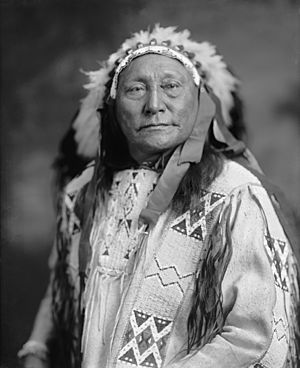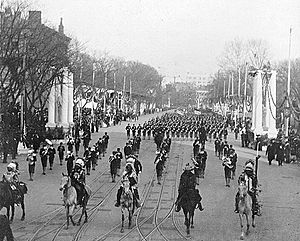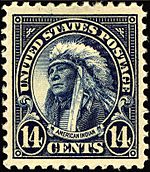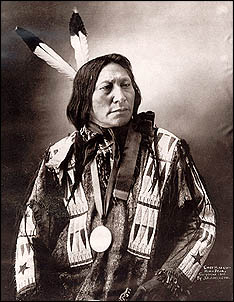Hollow Horn Bear facts for kids
Quick facts for kids
Hollow Horn Bear
|
|
|---|---|
| Matȟó Héȟloǧeča | |
 |
|
| Brulé Lakota leader | |
| Personal details | |
| Born | March 1850 Nebraska Territory, U.S. |
| Died | March 15, 1913 (aged 62-63) Washington, D.C., U.S. |
| Spouse | Good Bed |
| Relations | Grandson, Albert White Hat |
| Children | John Hollow Horn Bear |
| Parents | Father, Iron Shell |
Hollow Horn Bear (whose Lakota name was Matȟó Héȟloǧeča) was a respected Brulé Lakota chief. He was born in March 1850 and passed away on March 15, 1913. He was a brave warrior who fought in many important battles during the Sioux Wars, including the famous Battle of the Little Bighorn.
Later in his life, Hollow Horn Bear became the police chief of the Rosebud Indian Reservation. He played a key role in a major court case called Ex parte Crow Dog, which was heard by the Supreme Court of the United States. This case was very important for Native American rights. He also traveled to Washington, D.C. many times to speak for his people and negotiate with the U.S. government.
Hollow Horn Bear was so well-known that he even rode in the parades for presidents Theodore Roosevelt and Woodrow Wilson. He died in Washington, D.C., in 1913, after one of these trips. His image was later featured on a 1922 U.S. postage stamp and a 1970 $10 Military Payment Certificate. A special marker was put up in South Dakota in 1962 to honor him. In 2021, a museum in Germany returned a special leather shirt that belonged to him to his family, showing how important his legacy is.
Contents
Growing Up and Early Battles
Hollow Horn Bear was born in what is now Sheridan County, Nebraska. He was one of seven sons of Chief Iron Shell. When he was a young boy, he and his mother were captured by soldiers during the Battle of Ash Hollow. They were held at Fort Laramie National Historic Site for a short time before being released.
Hollow Horn Bear took part in many battles during the Sioux Wars. He was only 12 years old when he fought in his first battle. As a teenager, he fought alongside his father against the Pawnee and participated in raids across areas that are now Montana, Wyoming, and the Dakotas. He also fought against the U.S. Army and helped stop workers building the Union Pacific Railroad.
In 1874, Hollow Horn Bear married Good Bed, and they had seven children together. That same year, he started working as a scout for the U.S. Army.
In 1876, Hollow Horn Bear and his group joined up with Sitting Bull's camp. Soon after, they took part in the Battle of the Little Bighorn. Hollow Horn Bear later said he fought against both Marcus Reno and George Armstrong Custer in that battle. In 1880, he traveled to Washington, D.C., to talk with the U.S. government about issues on the reservation.
His Role as Police Chief
Hollow Horn Bear became the head of police at the Rosebud Agency in South Dakota. This was part of the Indian Police force, which was set up by the Bureau of Indian Affairs. In 1881, he arrested Crow Dog after a serious incident.
Hollow Horn Bear later testified in the important court case Ex parte Crow Dog. This case was heard by the U.S. Supreme Court. It became a major moment in how the U.S. government dealt with Native American tribes. The case even helped lead to the Major Crimes Act in 1885, which changed how certain crimes on reservations were handled. Hollow Horn Bear resigned from his police role five years later due to illness.
Advocating for His People

From 1890 to 1910, Hollow Horn Bear was a strong voice for the Lakota people. He worked hard during many negotiations with the U.S. government. Even though he couldn't stop the government from breaking some treaties, his presence helped protect Lakota interests. Many believed things would have been much worse for his people without his efforts.
In 1895, he was arrested during a disagreement about railroad workers' wages. The railroad company had cut the pay for members of his tribe. Hollow Horn Bear stood up for his people, even though it caused trouble.
In 1889, he was chosen to represent his tribe in talks with George Crook. These talks were about selling land in the Dakota Territory, including the Black Hills. Hollow Horn Bear was against selling the valuable Black Hills land. Instead, he wanted to sell less important prairie lands in other parts of South Dakota. He believed that owning land individually would protect his people better legally.
The U.S. government improved its offer for the land. Hollow Horn Bear asked for even more money for the best land.
In 1891, Hollow Horn Bear was part of a group that visited Washington, D.C. He met with the Secretary of the Interior and asked for his tribe to be paid back for lost property. He also asked for money owed to the tribe to be spent on cattle and horses instead of beef, because raising animals was more successful than growing crops at the time. He also requested more houses and schools for his people, saying he wanted the children to have a chance to learn.
In 1901, Hollow Horn Bear was part of another Lakota group that went to Washington, D.C. This was after the large Great Sioux Reservation was divided into smaller ones. In 1905, he was invited to President Theodore Roosevelt's inauguration. He rode in the parade with other famous Native American leaders like Geronimo and American Horse. That same year, he also took part in the Louisiana Purchase Exposition in St. Louis.
Later in his life, Hollow Horn Bear became a Catholic. The church had set up missions on the reservation. His daughter was baptized in 1907, and many other family members followed. Hollow Horn Bear himself was baptized and took the name "Daniel." He even spoke at a Catholic convention in Boston in 1906, after many in his tribe joined the Catholic Church.
His Final Days
In 1913, Hollow Horn Bear attended the dedication of the National American Indian Memorial. He spoke there for all the tribes. He also rode in President Woodrow Wilson's inauguration parade and gave Wilson a peace pipe made of South Dakota red clay.
During this trip to Washington, D.C., Hollow Horn Bear became sick with pneumonia. He passed away on March 15 at Providence Hospital. His funeral in Washington, D.C., was attended by hundreds of people, including chiefs from other tribes.
His body was sent back home by train, with a military escort. He was buried at the Rosebud Reservation, at the St. Francis Mission. In 1917, his son, Henry Hollow Horn Bear, asked to attend President Woodrow Wilson's next inauguration to continue his father's important role.
Honoring His Legacy
Hollow Horn Bear was honored on a 14-cent postage stamp in 1922. The stamp was based on a photograph of him.
A special historical marker was put up in Todd County, South Dakota, in 1962. It mentions his bravery in battles and his important role as a police captain and negotiator for his people.
On Money
Some sources say that Hollow Horn Bear's image was used on the U.S. five-dollar bill from 1899. One newspaper even reported that he hoped to take home many copies of his picture on the $5 certificates. However, other sources say the image on the five-dollar note was actually based on Running Antelope, another Lakota leader.
Some people also thought Hollow Horn Bear was on the buffalo nickel. But the coin's designer, James Earle Fraser, said he used features from several different Native American leaders to create a general image, not a portrait of one person.
Hollow Horn Bear was definitely featured on the 1970 to 1973 Series 692 Military Payment Certificate, which was used by the U.S. Military.
Returning His Shirt
In 2021, the Museum der Weltkulturen (Museum of World Cultures) in Germany returned a special leather shirt that belonged to Chief Hollow Horn Bear. They gave it back to his great-grandson, Chief Duane Hollow Horn Bear, and his family in Rosebud, South Dakota. The museum had owned the shirt since 1908.
Chief Duane Hollow Horn Bear had a photograph from 1900 showing his great-grandfather wearing the shirt. This photo helped him prove the shirt belonged to his family. The museum decided to return the shirt because it was very important to the Hollow Horn Bear family and the Teton Lakota community. They said the shirt was a "culturally specific, identity-forming object of religious significance." For the family, getting the shirt back felt like their great-grandfather was returning home.
See also
- Cultural assimilation of Native Americans
- List of Native American leaders of the Indian Wars
- List of American Indian Wars
- List of Native Americans of the United States
- U.S.–Native American treaties
- Population history of indigenous peoples of the Americas





